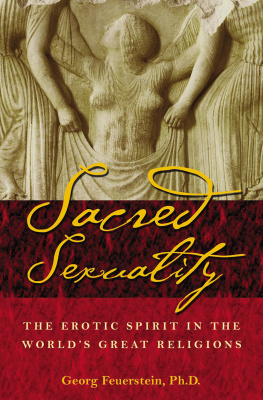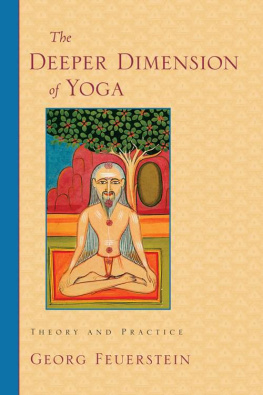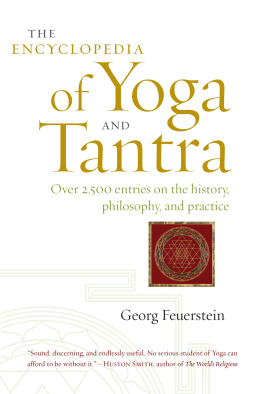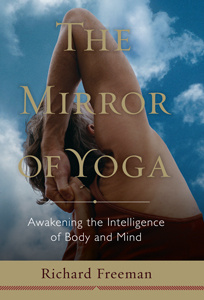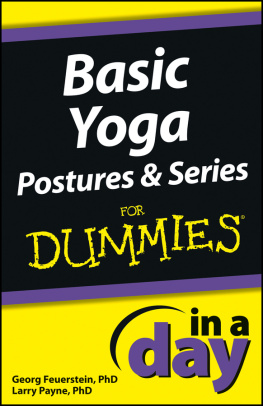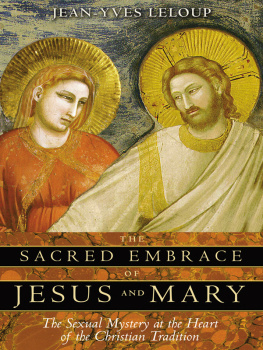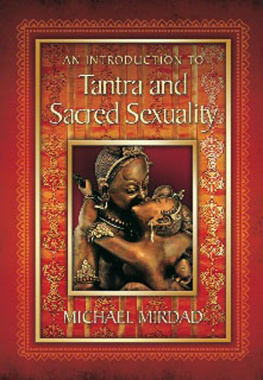

Acknowledgments
The many references in this book bespeak my indebtedness to many professionals in different areas of expertise.
I would like to thank the respondents to my questionaire and personal inquiry, as well as the editors of Common Boundary, Yoga Journal, and Magical Blend for printing announcements about my research. Thanks go also to John White for his moral support and a steady stream of magazine clippings; to Howard S. Levy for his helpful comments about Eastern sexuality and a free supply of his intriguing books on the subject.
I am also indebted to Ehud Sperling for putting this volume back in print and to Inner Traditions editorial team, notably Jamaica Burns, for sheperding it through the publishing process and making the experience an easy and pleasant one for me.
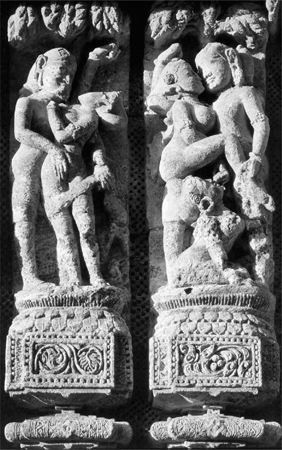
Erotic relief from the temple at Konarak, Orissa. Borromeo/Art Resource, NY.

Preface
Sacred Sexuality is about lovenot merely the positive feeling between intimates but an overwhelming reverence for all embodied life on whatever level of existence. Through sacred sexuality, we directly participate in the vastness of beingthe mountains, rivers, and animals of the earth, the planets and the stars, and our next-door neighbors.
Sacred sexuality is about recovering our authentic being, which knows bliss beyond mere pleasurable sensations. It is a special form of communication, even communion, that fills us with awe and stillness.
Sacred sexuality is about the reenchantment of our lives. It is about embracing the imponderable mystery of existence, about the curious fact that you and I and five billion others cannot account for our existence and our sexuality.
When we truly understand our sexuality, we come face-to-face with the mystery of the spirit. When we truly understand the spiritual dimension of existence, we come face-to-face with the mystery of sexuality And when we truly understand anything, we are immediately cast into mystery and wonder.
The average American apparently makes love twice a week. Assuming that the ordinary person commences sexual intercourse at the age of seventeen and can look forward to an active (if perhaps gradually declining) sex life for a period of at least fifty years, this means that he or she will have repeated the sex act some 4,800 times by the age of sixty-seven. For some people the figure will be much higher, perhaps around 8,000 times, while for a small minority it may be as low as a few hundred times.
Why, then, is it that countless people nevertheless feel dissatisfied and curiously ill at ease with their sexuality? Why is it that they feel a sense of shame or guilt about their genitals and about sex? Why do we generally hide our sexual feelings, sometimes even from our partner?
As Morton and Barbara Kelsey, who have given hundreds of workshops, noted in their book Sacrament of Sexuality, We have found very few people who, when they were honest, did not share real concerns about sexuality These concerns reveal a deep confusion about the proper place of sexuality in our lives. Despite the sexual revolution of the 1960s, and although we know that everyone does it, we feel strangely ambivalent about sex.
This book traces the causes of sexual malaise, showing how it is rooted in a deeper, spiritual dilemma: the obscuration of the sacred dimension in modern times. I will argue that there is another, more rewarding, challenging, and creative option to contemporary sex as performance. That option is sexuality as a transformative vehicle of higher human growth: sacred sexuality.
The present work has grown out of my own struggle with sexuality in the larger context of a meaningful life. Like so many people, I have for many years confused sexual need with the need to be loved and have passively expected to be loved rather than taken it on myself to love actively. I have explored many of the opportunities opened up by the sexual revolution, but these explorations gave me neither lasting happiness nor inner peace.
My own sexual dilemma did not begin to lessen until I seriously obliged myself to integrate my sex life with the deeply felt urge to become a whole person. Ten years ago, I voluntarily adopted a lifestyle that required me to inspect closely the psychological mechanism that made me a sexual and emotional consumer rather than a fully cognizant participant in the play of life. Luckily I have a partner who was willing to experiment with different approaches to this problem, which, I believe, lies at the core of the existential dissatisfaction experienced by numerous men and women today.
For a period of time we made love daily, working through our respective problems and learning to be vulnerable with each other. Then we economized our sexual life and even practiced celibacy for a stretch. More than anything, that period of voluntary sexual abstinence allowed me to really see my own habit patterns. Step by step, I succeeded in disentangling the sexual drive from my emotional needs. I became a little freer in myself, a little less guilt-ridden, and more capable of genuine love. In due course, I also found myself more able to invite the sacred into my intimate life.
I looked to such traditional spiritual schools as Hindu Tantrism and Chinese Taoism for practical guidance. My professional training as an indologist specializing in the Sanskrit literature of Hinduism particularly qualified me to investigate the original sources of Tantrism. My research in this area prompted me to contribute a series of articles on Tantrism to the widely read Yoga Journal.
The favorable response to these essays subsequently induced me to conceive and edit the book Enlightened Sexuality, published in 1989. With that anthology I tried to give voice to a sex-positive spiritual orientation to counterbalance the inherited Christian puritanism from which many of us are still suffering.
Encouraged by the public response to Enlightened Sexuality and feeling that there was room for a more systematic treatment of sexuality in the context of a sacred life, I next embarked on the present work.
This book is arranged in three parts. In , I review the stark reality of our contemporary sexual malaise, or what I call the sexual stress syndrome. I also trace the roots of the modern sexual dilemma and unhappiness to what I call modal guilt and shame, the denial of the body, and the felt sense of being cut off from the ground of existence.
I further show that sex need not be a dull routine or dreaded twice-a-week or once-a-month encounter. It can be a healing event and one that reconnects us to the sacred dimension of existence. I include many first-person accounts of men and women who have experienced the sacred aspect of sexuality, which demonstrate that sex can be a window onto the ultimate reality, whose presence can make us whole.
Traditional cultures, which do not recognize our modern separation between sacred and profane, have always considered sexuality as an aspect of the great mystery of existence. I believe that these cultures contain many important clues for us. Hence the core chapters of this volume, those of , are dedicated to an overview of the significant ways in which traditional societiesform the Stone Age to own erahave integrated sexuality into their religious-spiritual world views
Next page
